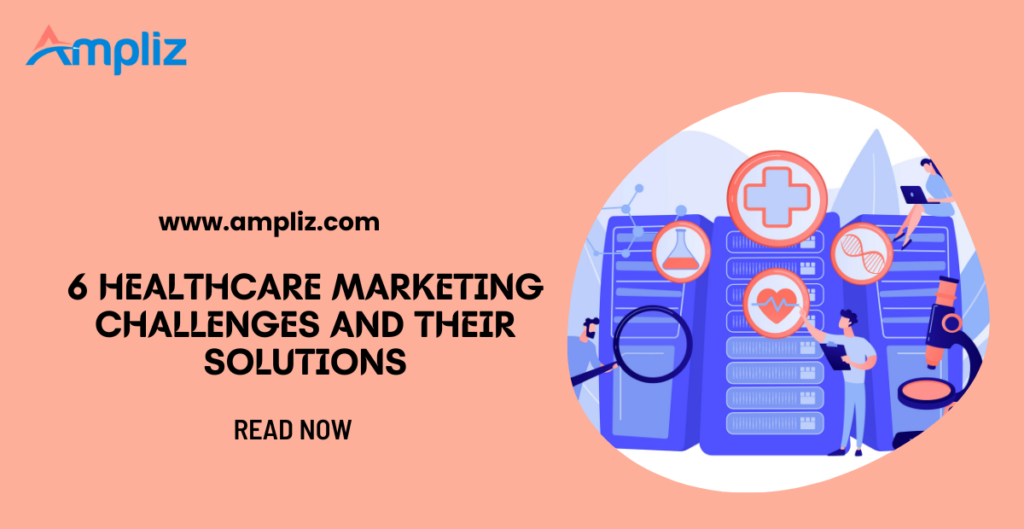Healthcare marketing is a different ball game compared to marketing in other industries.
While each market has opportunities and threats, the healthcare industry’s data-sensitive and highly regulated nature limits what marketers can do to build authentic connections with customers. These unique healthcare hurdles impact how you conduct patient outreach and which technologies to adopt.
Marketers must understand the key healthcare marketing challenges and implement effective solutions or risk criminal and monetary punishments, including legal suits and violation penalties.
So, what are the biggest hurdles to promoting medical products, and how can you overcome them? This article will examine six healthcare marketing challenges and their solutions, from patient privacy to reputation management.
What Is Healthcare Marketing?
Healthcare marketing is the purposeful promotion of healthcare services, facilities, and professionals to specific audiences, including patients, caregivers, and referring healthcare providers.
It involves activities that create awareness, build trust, and establish positive relationships within the healthcare community. With the use of different channels and messaging techniques, healthcare marketing aims to educate, engage, and influence individuals in their healthcare choices, ultimately leading to better patient outcomes and the success of healthcare organizations.
Like many industries, healthcare has undergone transformational changes due to technological advancements and changes in consumer behavior. Consequently, medical marketing has evolved from traditional sales strategies to personalized marketing campaigns.
But what makes healthcare marketing even more challenging is the requirement for strict compliance with the Health Insurance Portability and Accountability Act (HIPAA). HIPAA safeguards patients’ protected health information (PHI) by limiting the use and disclosure of said information. PHI includes biometric information, medical data, and personal identifiable information.
Compliance isn’t just required of the healthcare service providers themselves. It’s also required of healthcare associates such as marketers.
6 Key Healthcare Marketing Challenges and Effective Solutions
There are several key challenges in healthcare marketing organizations need to overcome to succeed. These include the need for regulatory compliance and the lack of patient trust. Let’s examine the following obstacles to medical marketing and how you can overcome them.
1. Lack of Patient Trust
The U.S. healthcare system is complicated, with the seemingly limited agency given to patients. For instance, purchasing decisions on prescription drugs ultimately fall under the purview of the healthcare provider, insurance, and pharmaceutical companies. In essence, they tell patients what they should buy to prevent, treat, or cure their diseases.
The complexity of the industry creates a negative public perception, making a lack of patient trust one of the top healthcare marketing challenges.
One solution for this, though, is increased transparency. Share information about your pricing structures, services, and patient outcomes.
Take your cue from the John Hopkin’s All Children’s Hospital, which publishes its charge list. The final amounts vary by insurance plan, but at least patients know how much treatments cost. Price transparency doesn’t just help build trust. It is also a requirement for U.S. hospitals.
Another way to gain public trust is to share patient testimonials and success stories. Statistics on social proof show that 87% of consumers read reviews of local businesses online.
Real stories not only humanize your practice but also provide credibility.
The Beverly Hills Cancer Centre, for instance, even puts a face to its testimonials on its website. However, since testimonials divulge PHI and directly identify patients, you must have written permission from these patients to be HIPAA-compliant.
If you can’t publish the faces of your patients, consider your employees. Feature stories about your workers or include them in promotional content. But you have to have a strategy for building trust. Patient trust is important in healthcare marketing. It can lead to better patient retention and referrals.
2. Required Regulatory Compliance
Healthcare organizations must comply with strict rules and regulations even when marketing. Regulatory compliance means following legal and industry standards. With regulatory compliance, healthcare organizations can protect against legal issues and reputational harm.
HIPAA touches every aspect of the healthcare industry and has strict guidelines for how marketers can use patient information.
Specific forms of promotion and advertising, such as retargeting, for instance, are unlawful. Retargeting is a digital marketing strategy that allows businesses to target audiences who have visited their web pages.
So, let’s say a customer visits your dermatology website. You can’t bombard them with banner ads on those specific services that customer checked out. When prospective patients visit healthcare websites, they disclose their medical conditions. You cannot use this information for marketing without their consent.
HIPAA also limits how marketers segment audiences. Segmentation based on health conditions or treatment history is not allowed.
Fortunately, there are a couple of solutions to ensure compliant marketing.
- Train your marketing teams on the impact of the HIPAA Privacy Rule.
- Use opt-in forms to get patient content to use some of their data for marketing.
- Create audience segments based on generalized demographic or psychographic data.
Plus, there are other ways you can reach prospective customers while ensuring regulatory compliance.
One way is through search engine marketing (SEM). Essentially, you’re buying digital ad space by bidding on keywords or phrases clients use to search for your product or service.
The two top two results seen above, for instance, are paid ads for the search term ‘gastric weight loss UK.’
But paid advertising for high-volume keywords can get expensive, especially for a startup health company. The good news is, you can supplement this marketing strategy with inbound/content marketing.
Inbound marketing attracts healthcare consumers by creating content tailored to specific audiences. Popular types of content marketing include blogs, videos, eBooks, and podcasts.
The advantage of content marketing is it goes hand-in-hand with SEO. Getting the top spots on SERPs requires consistent, compelling content and effective keyword use. Fortunately, generative AI tools accelerate the process of creating SEO-optimized content.
By implementing these measures, healthcare organizations can operate confidently in complex regulatory environments, reducing risks and strengthening their competitive edge in the market.
3. Need for Digital Transformation
Healthcare organizations can’t operate well without harnessing technology. They need to harness tools to improve communication, accessibility, and efficiency. This allows healthcare providers to reach more people, offer convenient services, and engage patients online. It also enables personalized marketing and data-driven insights for better targeting.
But embracing digital transformation requires a lot of effort and financial resources. Overall, the average digital transformation can cost enterprises an average of $27.5 million. Then there’s the cost of training employees.
Despite these limitations, it’s still more cost-effective to undergo a digital transformation than forgo it. Digitally-transformed organizations, after all, are expected to contribute to more than half of a country’s Gross Domestic Product by 2023.
To overcome this challenge, invest in these primary marketing technologies:
- Project Management Tools – help plan, manage, and track marketing campaigns. hey streamline collaboration, assign tasks, and ensure timely project delivery. Project management software also provides real-time insights, improves resource allocation, and boosts overall team productivity.
- Customer Relationship Management (CRM) Tools – store customer data, from demographics to user interactions.
- Email Marketing Tools – accelerate outreach with an email finder and automate email campaigns.
- Social Media Tools – analyze the performance of social media advertising campaigns.
- SEO Tools – help improve website rank and visibility on search engine results pages
- Analytics Tools – collect data on your medical marketing campaigns across various platforms.
- Reputation Management Software – determine your healthcare organization’s reputation among patients
Note, though, that there are regulatory implications for the tools you use. To ensure HIPAA compliance, you’ll need to look for these features: two-factor authentication (2FA), access controls, audit logs, and end-to-end encryption (E2EE).
2FA verifies users through multiple unique login credentials. Access controls, meanwhile, limit access to sensitive data based on job function. Audit logs ensure data is accessed appropriately while E2EE prevents unauthorized access to data using decryption keys.
Remember, too, that marketing software isn’t considered HIPAA-compliant without a signed Business Associate Agreement (BAA). This legal contract outlines the vendor’s obligations to maintain patient data compliance and security.
4. Limited Marketing Budgets
It takes money to make money. Still, many medical organizations don’t see the value of marketing when they could spend money on new or used medical equipment, for example. In fact, marketing spending has dropped.
With limited marketing budgets, healthcare organizations need a focused and efficient resource allocation strategy. It’s also important to prioritize cost-effective channels and creative messaging for targeted content development. A data-driven approach for measuring and optimizing marketing impact is also key.
That said, here are practical solutions for healthcare organizations to optimize small marketing budgets and still achieve desired outcomes.
- Identify and focus on marketing channels with high ROI.
- Leverage social proof to maximize the impact of your messaging.
- Prioritize local SEO to increase your digital presence on local searches.
- Adopt marketing automation tools to increase efficiency.
- Explore content marketing opportunities like guest blogging.
- Utilize free tools like Google Analytics to track web traffic and marketing effectiveness.
By strategically managing limited budgets, healthcare organizations can compete effectively, reach their target audiences, and achieve meaningful ROI, even with fewer resources.
5. Negative Reviews
Customer testimonials and positive reviews are powerful tools. However, some medical practitioners don’t use them because of fear of negative feedback. We all know the impact of negative feedback. Negative reviews directly influence a provider’s credibility and patient trust. A whopping 40% of consumers won’t deal with a business because of negative reviews. A staggering 57% will also only deal with a business with four-star reviews or more.
But negative feedback can be a good thing, too. Negative feedback provides valuable insight into patient satisfaction levels and identifies areas for improvement. If you address negative feedback, you can enhance your medical services and earn positive feedback in the future.
You can also further turn things around by promptly responding to negative feedback online. When potential patients see your team responding to negative comments as soon as they leave them and in a professional way, they’ll conclude you care about what they think. By handling negative feedback this way, you can minimize reputational harm.
But don’t just respond to negative feedback. Respond to positive feedback, too.
See how Tulsa Premier Dentistry does it. The business doesn’t just thank reviewers for the feedback. It invites them to return as well.
Also, as I said earlier, invest in reputation management software. These tools monitor and notify you of online reviews from your website, social media, search engines, and other platforms. Start with notifications for Google reviews and move to paid platforms like Trustpilot. You can also engage professional PR services who can help you maintain your positive brand reputation.
Another way to manage your reputation is to encourage current patients to complete surveys. Since you give them the opportunity to evaluate your services right after they’ve availed of them, the chances of them airing their grievances – if any – in public decrease.
By actively managing online reviews and maintaining a positive reputation, healthcare providers can build patient trust, attract new clients, and stand out in a competitive market, ultimately overcoming challenges tied to public perception and competition.
6. Changing Patient Behavior
Today’s patients are more empowered than ever. They have assumed a more active role in researching their healthcare options. Modern patients now research health conditions and collaborate with doctors on appropriate treatment courses.
Also, there’s now a market for telehealth services. For many, virtual medicine offers multiple benefits. It cuts down wait time, removes the need to travel, therefore helping minimize exposure to disease, and gives remote or immobile patients access to health services. A staggering 80% of consumers have used telemedicine at least once.
If they want to succeed, the marketing departments of healthcare organizations need to continuously adapt to these patient behavior changes when promoting their companies. Gone are the days healthcare organizations can just wait for patients to come to them. They have to be proactive in analyzing patient behavior.
Once they’ve determined behavioral trends using analytics tools, marketers should incorporate these trends into their marketing strategies and messages. For instance, with patients now assuming a more active role in healthcare research, healthcare marketing departments should now meet potential customers where they are. That’s why social media marketing and even maintaining a website are now a must for healthcare organizations.
Also, since there’s now an emphasis on convenience as highlighted by the popularity of virtual telemedicine, marketers need to shift their messaging to highlight their healthcare organization’s services that allow for the same.
Understanding these behavioral shifts enables healthcare organizations to customize, not just their services, but also their communication methods. Targeted marketing efforts that resonate with patients ultimately result in better healthcare promotional outcomes.
In Closing
Medical marketers face unique healthcare hurdles due to the complex nature of the industry. While the work is challenging, it can also be rewarding. Marketing obstacles like compliance, competition, and public perception give way to new opportunities.
This article explored key healthcare marketing challenges and effective solutions to solve them. These marketing obstacles included limited budgets, the lack of patient trust, the need for regulatory compliance and digital transformation, and negative reviews.
By leveraging digital technologies and developing patient-centered strategies, healthcare marketers can still create targeted campaigns that resonate with audiences and comply with privacy regulations.
Meta description: To ensure success, healthcare organizations need to overcome industry-related hurdles. Learn the six key healthcare marketing challenges and their solutions.




